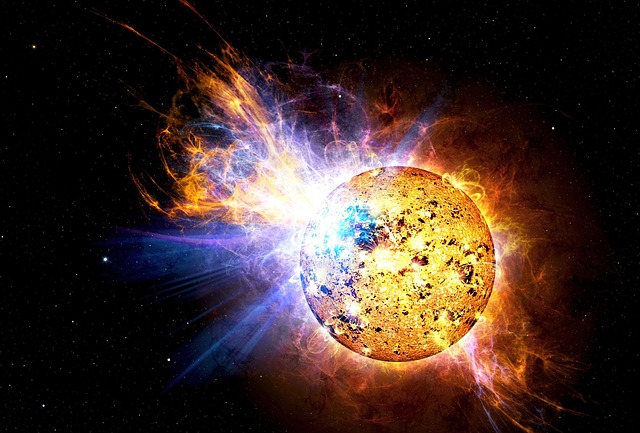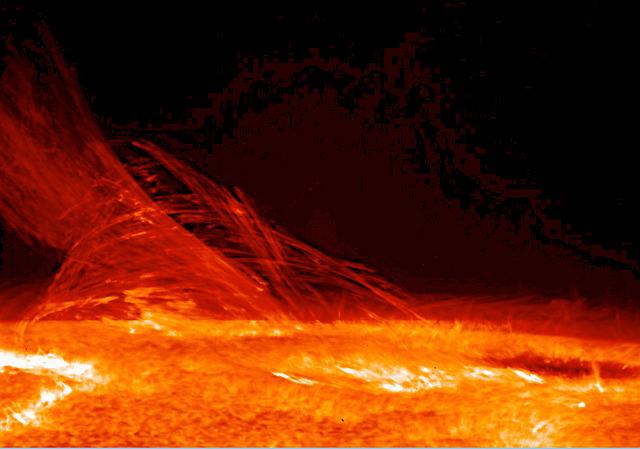*This post may contain affiliate links. This means we may make a commission if you purchase an item using one of our links*
The hot, fiery atmosphere of the Sun creates an array of remarkable and intriguing features. Two of these are solar prominences and solar flares, but while the former is an unthreatening loop of plasma, the latter is a dangerous burst of energy that has the potential to affect life on Earth.
Continue reading to find out what a prominence and a flare are, plus the similarities and differences between these two forms of solar activity.
What Is A Solar Prominence?
Table of Contents

A solar prominence is a large, luminescent feature that extends out from the surface of the Sun. These protrusions are anchored in place by the photosphere and extend out into the corona (the Sun’s outer atmosphere).
A prominence can form in as little as a day, and when stable, it can last for several months, looping out thousands of miles into space. It’s reasonably easy for astronomers to spot these bright loops as they contrast against the black backdrop of space.
When we see a dark prominence against a bright drop, we call it a “filament.” In essence, this is the same as a prominence; the different names just reflect how we observe this phenomenon.
The primary ingredient in these red loops is plasma, a hot gassy combination of hydrogen and helium particles carrying an electric charge. This plasma flows along the winding pathways of the Sun’s magnetic fields (generated from the internal dynamo of the Sun). And it’s this complex field that gives a prominence its shape.
These loops may appear extremely hot and bright to us, but their temperature is nothing compared to the Sun’s corona, which sits at 5,500 degrees celsius.
What Is A Solar Flare?

A solar flare is a burst of radiation from the release of magnetic energy around sunspots. These are the most enormous explosions in our solar system and appear to us as bright areas on the Sun that last from a few minutes to several hours. A “flare” can also refer to a site where particles such as protons and electrons accelerate.
These vast explosions occur when there is a sudden release of stored energy from the twists of the magnetic fields. The material heats to millions of degrees in just a few minutes, producing a radiation burst.
Inside the Sun is a sort of magnetic dynamo created by gases that generate electrical currents. Because these dynamos comprise turbulent gases, their magnetic fields constantly twist, turn, and rearrange themselves, creating an unsettled magnetic field.
We refer to the turbulent behavior of this magnetic field as “solar activity,” and it’s this instability that creates the potential for solar flares.
Astronomers can view a solar flare thanks to the photons it releases at almost every wavelength on the spectrum, including x-rays, gamma rays, and radio waves.
Scientists then class these flares in accordance with their brightness. An X-class flare is the largest; this significant event can cause global radio blackouts and radiation storms in our atmosphere’s upper levels.
M-class flares are mid-range flares that cause only brief radio blackouts and can affect Earth’s polar regions. C, B, and A-class flares are the smallest fairs, which have minimal impact on Earth compared to the X-class or M-class varieties.
A coronal mass ejection is similar to a solar flare, but it contains much more material than the latter. These solar occurrences have puzzled scientists for many years, but many believe they behave in relation to the force of the strong magnetic fields that surrounds them.
How Are Solar Prominences And Solar Flares Similar?
Sunspots are comparatively cool areas of the Sun whose surrounding photosphere often erupts with a high energy flow of particles. These eruptions lead to the formation of both solar prominences and solar flares.
Both of these phenomena are caused by the magnetic fields of the Sun and sudden releases of stored energy. But where a prominence generally creates a cool cloud of ionized gas in the Sun’s corona, a flare explodes outwards, gathering additional heat and energy as it breaks through the Sun’s atmosphere.
The other similarity is that both solar prominences and solar flares can transmit harmful radiation to Earth. However, when it comes to a prominence, this is very unlikely to do any significant harm. In contrast, a flare does carry the potential to wipe out the planet (in extreme circumstances).
Differences Between Solar Prominences And Solar Flares.
The key difference between these two forms of solar activity is that solar prominences do not threaten Earth, whereas solar flares do.
If we examine the solar flare of 1859, we see that the vast mass ejection from the corona caused a geomagnetic storm that severely damaged the infrastructure of Earth. Considering that the only major electrical infrastructure in those times was the telegraph, it wouldn’t be difficult to imagine how much damage a solar flare could do to today’s society, which is so heavily dependent on technology.
If a solar flare were to strike Earth today, it would be a disaster for both the electrical infrastructure and the internet, significantly impacting many lives.
Meanwhile, astronomers worldwide can enjoy the light dance of solar prominences as these plasma loops are still primarily contained by the Sun’s own atmosphere and pose very little threat to us.
In addition, a solar flare is a much faster ejection than that of a prominence. A flare can reach up to 5% light speed.
Put simply; a solar prominence remains in the Sun’s magnetic field while a flare escapes the Sun’s reach and scatters an array of waves across the galaxy.
Summary
Both solar prominences and solar flares occur from stored energy around the magnetic fields of the Sun. But a solar prominence is far more tranquil than a solar flare. While the former creates a cool arch, still attached to the Sun and primarily contained in the Sun’s magnetic field, a flare bursts out with high speed and energy, casting out harmful radiation to any surrounding planets.
References
What is a solar prominence? | NASA
Solar Prominences | Center for Science Education (ucar.edu)
What is a solar prominence? | Astronomy.com
How Are Solar Flares Different From Solar Prominences – Realonomics


